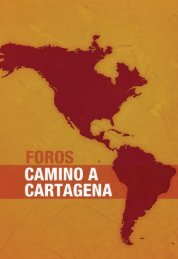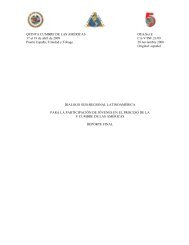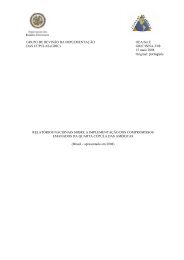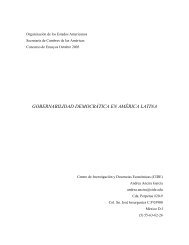The Road to Hemispheric Cooperation: Beyond the Cartagena
The Road to Hemispheric Cooperation: Beyond the Cartagena
The Road to Hemispheric Cooperation: Beyond the Cartagena
Create successful ePaper yourself
Turn your PDF publications into a flip-book with our unique Google optimized e-Paper software.
<strong>The</strong> current situation is important: It calls not for recoiling<br />
and turning our backs on liberalization, but for closer trade<br />
integration and liberalization. Agreements are not enough<br />
in a world of fierce competition. <strong>The</strong> future agenda has <strong>to</strong><br />
span beyond agreements and include measures that facilitate<br />
doing business across borders—improving cus<strong>to</strong>ms,<br />
logistics and infrastructures, as well as building relationships<br />
with consumers in foreign markets and multinational<br />
firms (potentially major regional clients for LAC’s small and<br />
medium-sized firms). Only <strong>the</strong>n can <strong>the</strong> hard-earned integration<br />
of <strong>the</strong> past two decades be fully harnessed for trade,<br />
growth, and development.<br />
Endnotes<br />
1 U.N. COMTRADE database.<br />
2 <strong>The</strong>se countries are: Antigua and Barbuda, Argentina, Bahamas,<br />
Barbados, Belize, Bolivia, Brazil, Chile, Colombia, Costa Rica,<br />
Dominica, <strong>the</strong> Dominican Republic, Ecuador, El Salvador, Grenada,<br />
Guatemala, Guyana, Haiti, Honduras, Jamaica, Mexico,<br />
Nicaragua, Panama, Paraguay, Peru, Saint Kitts and Nevis,<br />
Saint Lucia, Saint Vincent and <strong>the</strong> Grenadines, Suriname, Trinidad<br />
and Tobago, Uruguay and Venezuela. Only Cuba was not<br />
invited <strong>to</strong> participate.<br />
3 John Williamson, author of <strong>the</strong> phrase “Washing<strong>to</strong>n Consensus,”<br />
identified ten key reforms that Latin America should have<br />
implemented in 1989: fiscal discipline, reordering public expenditure<br />
priorities, tax reform, liberalizing interest rates, adopting a<br />
competitive exchange rate, trade liberalization, liberalization of<br />
FDI, privatization, deregulation, and property rights (see John<br />
Williamson, “Did <strong>the</strong> Washing<strong>to</strong>n Consensus Fail?” (Peterson Institute<br />
for International Economics, 2002). Available at: www.iie.<br />
com/publications/papers/paper.cfm?ResearchID=488.<br />
4 IMF Direction of Trade Statistics, 2012.<br />
5 In 2010, <strong>to</strong>tal exports of goods and services reached about<br />
$1.015 trillion; <strong>to</strong>tal imports of merchandise goods and services<br />
was $1.028 trillion. Based on <strong>the</strong> World Bank World Development<br />
Indica<strong>to</strong>rs database, 2012.<br />
6 Intra-regional trade in Latin America and <strong>the</strong> Caribbean excludes<br />
<strong>the</strong> United States and Canada.<br />
7 Richard E. Feinberg, Summitry in <strong>the</strong> Americas: A Progress Report<br />
(Washing<strong>to</strong>n, D.C.: Institute for International Economics, 1997).<br />
8 Samuel P. Hunting<strong>to</strong>n, <strong>The</strong> Third Wave: Democratization in <strong>the</strong><br />
Late Twentieth Century (University of Oklahoma Press, 1991).<br />
9 An<strong>to</strong>ni Estevadeordal, Dani Rodrik, Alan M. Taylor, and Andrés<br />
Velasco, Integrating <strong>the</strong> Americas: FTAA and <strong>Beyond</strong>. (Cambridge:<br />
Harvard University Press, 2004).<br />
10 Nicola Phillips, “Coping with China,” in Andrew F. Cooper and<br />
Jorge Heine (eds.), Which Way Latin America? <strong>Hemispheric</strong><br />
Politics Meets Globalization (Tokyo: United Nations University<br />
Press, 2009), pp. 100-121.<br />
11 Osvaldo Rosales, José E. Durán Lima, and Sebastián Sáez,<br />
“Trends in Latin American Integration,” in Joseph A. McKinney<br />
and H. Stephen Gardner (eds.), Economic Integration in <strong>the</strong><br />
Americas (New York: Routledge, 2008).<br />
12 An<strong>to</strong>ni Estevadeordal and Kati Suominen with Jeremy Harris<br />
and Mat<strong>the</strong>w Shearer, Bridging Regional Trade Agreements<br />
in <strong>the</strong> Americas (Washing<strong>to</strong>n: Inter-American Development<br />
Bank, 2009).<br />
13 <strong>The</strong>se are: Belize, Chile, Colombia, Costa Rica, Dominican Republic,<br />
El Salvador, Guatemala, Honduras, Mexico, Nicaragua,<br />
Panama, Peru and Uruguay.<br />
14 <strong>The</strong>se are: <strong>the</strong> United States, Canada, Mexico, Chile and Peru<br />
(Estevadeordal and Suominen, 2009).<br />
15 In <strong>the</strong> Americas, U.S., Chile and Peru are formally members of <strong>the</strong><br />
TPP, and Mexico and Canada have been also formally invited.<br />
16 <strong>The</strong>se are: Argentina, Bolivia, Brazil, Chile, Colombia, Ecuador,<br />
Guyana, Paraguay, Peru, Suriname, Uruguay and Venezuela.<br />
<strong>The</strong> <strong>Road</strong> <strong>to</strong> <strong>Hemispheric</strong> <strong>Cooperation</strong>: <strong>Beyond</strong> <strong>the</strong> <strong>Cartagena</strong> Summit of <strong>the</strong> Americas<br />
<strong>The</strong> Brookings Institution ❘ Latin America Initiative<br />
29








